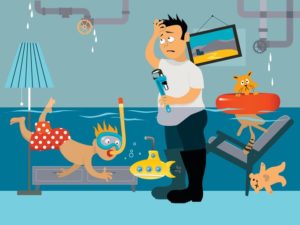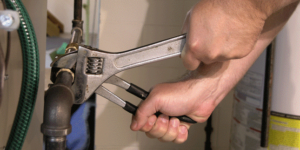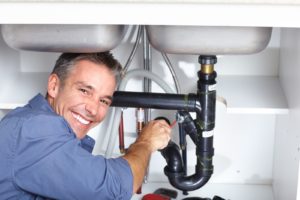Plumbing
How You Can Benefit from a Water-Powered, Back-up Sump Pump
The key to maintaining a dry basement is, well, taking every preventive step you can to keep water out. But nature and your indoor plumbing each has a way of sneaking up on you and greeting you one day with a watery mess.

So, and for starters, if your home or neighborhood is prone to basement flooding, you’ll want to install a main sump pump as your first line of defense. They do, however, have one limitation: they run on electricity. Should you therefore lose power, your pump will immediately shut down. Or, what if your pump breaks down for mechanical reasons?
Not to worry, because should it suddenly fail for any reason, you’ll be protected by installing a water-powered back-up sump pump. Each one is apable of pumping more than 1,300 gallons per water out of your basement. And, because water-powered pumps require neither electricity nor batteries to operate – just pressure from your main water line – they can run indefinitely even under extremely trying conditions.
Another big plus about a water-powered sump pump is that it requires virtually no maintenance.
To learn how best to protect your basement and valuables from water and any resulting damage, contact Boden today to request a free in-home proposal. At Boden, we install only high quality sump pumps and, where maintenance is required, you can count on us to keep your sump pumps and all your plumbing in top working condition.
Conserve More Water with a Dual-Flush Toilet
 As technology evolves, you have more and more green living options essentially handed to you on a silver platter. And we’re all better off for it.
As technology evolves, you have more and more green living options essentially handed to you on a silver platter. And we’re all better off for it.
Let’s say, for example, you’re ready to replace an older toilet, the kind that uses between three and five gallons of water per flush. You might be surprised to learn you can no longer purchase such a water guzzler, and that low-flush toilets that use between 1.3 and 1.6 gallons per flush are the new default toilet purchase.
Well, you have another option beside that: a dual-flush toilet for the ultimate in water consumption. Just as its name suggests, a dual-flush toilet has two flushing modes: half-flush for liquid waste, and full-flush for solid waste. These toilets consume only .8 of a gallon for a half flush, and 1.6 gallons for a full flush.
How much water can you save by switching from your older toilet to a dual-flush model. According to the Sierra Club, a family of four will save an average of 7,000 gallons per year.
One more thing about dual-flush toilets to keep in mind: less water does not mean more toilet blockages. Quite the opposite, in fact, since dual-flush toilets have greater flushing power and in-bowl traps about twice the size of older style toilets, thus virtually eliminating the potential for clogged toilets.
Have questions before you buy? At Boden, we’ll be happy to answer them for you and provide the new toilet solution that works best for your home and family. To learn more or schedule installation, contact Boden today, your Sonoma Valley plumbing professionals.
How to Detect Electric Water Heater Problems
Knowing that your electric water heater is not going to last forever, you can do yourself a world of good by keeping an eye on it, especially once it starts getting up there in years.
Just to put some numbers to it, your water heater has a projected lifespan of 10-12 years (up to years if you have a tankless system). Once it hits 6 or 7 years old, it’s time for some closer surveillance. That way, you’ll be able to spot early warning signs of trouble and can get them fixed before the problem gets worse.
These are the primary indications that trouble is brewing
Water Leaking from the Top
 If you see or suspect water is leaking from the top of your electric water heater, it probably means the cold inlet or hot outlet pipes are loose, that the T&P valve has failed, or the inlet valve is leaking. These are all very fixable issues.
If you see or suspect water is leaking from the top of your electric water heater, it probably means the cold inlet or hot outlet pipes are loose, that the T&P valve has failed, or the inlet valve is leaking. These are all very fixable issues.
Water Leaking from the Bottom
This could be caused by something as simple as normal condensation. But water leaking from the bottom of your electric water heater also could indicate a leaking gasket or that a small amount of water has been expelled through the overflow pipe. Worst case scenario, the leak stems from internal tank corrosion. If that’s the case, you’ll need to replace your system.
No Hot Water
Several possibilities here. First, the circuit breaker may have tripped – the ultimate easy fix. Or, perhaps the heating elements have failed or there’s an issue with the thermostat’s limit/reset switch. If the unit has power, try re-setting the switch. If that fails to deliver the desired result, you’ll probably need to call a plumber.
Not Enough Hot Water
If you’re running out of hot water at all, or faster than you recall, chances are there’s a problem with your system’s thermostat. During the cold weather months, raising the thermostat might be enough to solve the problem. On most models, you’ll find the thermostat on one side of the tank in a compartment and behind a layer of insulation.
Dirty or Rust-Colored Water
Rusty hot water usually indicates corrosion on the walls of storage tank or what’s called the sacrificial anode rod. The latter is so named because it’s “job” is to sacrifice itself to internal corrosion to spare the storage tank. Either way – storage tank or anode rod – call your plumber once you notice rusty water to have the exact cause diagnosed.
Smelly Hot Water
The likely culprit? Bacteria inside the tank, which can easily be flushed out.
If your electric water heater is displaying any of these warning signs, contact Boden Plumbing Heating & Air today for prompt scheduling, expert problem diagnosis, plus a guaranteed upfront price quote for the repair or replacement work we recommend.
How to Maintain Your Garbage Disposal
Even though you already know your garbage disposal won’t last forever, what’s wrong with it lasting “longer than expected”?
Absolutely nothing! And Boden Plumbing Heating & Air is here to explain how you can accomplish that money-saving goal:
- Feed your disposal a little at a time. While you’re at it, take care to keep utensils and your hands out of the drain.
- Keep all fibrous foods out of the disposal since they’re likely to clog your drain – the disposal simply can’t properly grind them. That goes for food scraps like corn husks, onion skins, celery, and most soft vegetables.
- Deodorize the disposal. Cut a lemon into small pieces and drop the fruit into the disposal along with some baking soda or distilled white vinegar. Turn on the cold water faucet and then the disposal. The unit will clean itself as it grinds up the mixture. Use a strong flow of cold water and keep it running at least 30 seconds after the grinding noise has stopped. This helps to flush food all the way down the drain line.
- Do not put uncooked meat fat or liquid fats into your disposer.
Still, even with all the “TLC” in the world, sooner or later you’re bound to run into a problem. In fact, you probably have one if you hear or see any of the following signs:
 If the disposal won’t run, check the circuit breaker or fuse and replace or reset/replace as necessary. Also check to see if the disposal’s overload switch has tripped. Locate the reset button at the bottom of the disposal unit and push it.
If the disposal won’t run, check the circuit breaker or fuse and replace or reset/replace as necessary. Also check to see if the disposal’s overload switch has tripped. Locate the reset button at the bottom of the disposal unit and push it.
- If the motor hums but the disposal doesn’t run, you may have a jammed impeller – that can be fixed.
- If the disposal runs intermittently, the switch or stopper may be defective. If so, it’s probably time for a replacement unit.
- A leaky garbage disposal isn’t necessarily a sign of rust. The cause might be as simple as a loose connection, which easily can be tightened.
- If your disposal starts making a racket, turn it off immediately; chances are, something was being ground up that didn’t belong in there in the first place, like a meat bone. If you stop it in time, no harm. If not, you could be facing a damaged blade, impeller or motor.
Like all other plumbing fixtures and systems, treat your garbage disposal with care, and it will give you more years of uninterrupted service. But if and when it needs a little help to continue, one call to Boden will get you all the professional help you need.
Common Toilet Tank Problems & How to Fix Them
 When it comes to toilet troubles, the dreaded clogged and overflowing toilet bowl is one that can send most homeowners into a temporary state of panic. But things can wrong with your toilet tank, too, but usually they’re a lot easier and less stressful to resolve.
When it comes to toilet troubles, the dreaded clogged and overflowing toilet bowl is one that can send most homeowners into a temporary state of panic. But things can wrong with your toilet tank, too, but usually they’re a lot easier and less stressful to resolve.
Let’s have a look.
Toilet won’t stop running.
A continuously running toilet is more than annoying – it can be quite wasteful and costly as it constantly sends clean water down the drain.
- First, check the handle to see if it’s loose or broken.
- If the handle seems intact, remove the tank lid and check to see if the chain that connects the flushing handle to the ball valve is loose, tangled, or broken, as it could be preventing the ball valve from closing completely.
- Also check the ball valve for damage. Does it close on its own, or is it stuck?
Toilet doesn’t fill with enough water.
When this happens, too little water is being sent into the bowl following a flush, and that could result in your toilet clogging.
- Is the toilet water supply valve in the open position? Turn it to the right, then to the left, and see if the tank starts filling up with water.
- If the water supply valve is fully open, you could have a problem with the float level. In an older toilet, you can adjust the float level by bending the metal arm upward. Newer toilets either have a small clip that you can pinch and slide the float up along the rod, or a screw that you turn, one that’s located on top of the float.
- The fill valve could be clogged. The fill valve is what moves water into the tank over time, it can become clogged with mineral deposits or debris. Shut off the water to the toilet, remove the fill valve cap, and let the water run for a few seconds to flush out the debris. If this doesn’t work, you may need to replace the fill valve.
Cracks in your toilet tank are pretty easy to locate and repair, especially those above the water line. But whatever the problem, count on Boden Plumbing Heating & Air for assistance if you don’t have the time, tools, or inclination to fix it yourself. We’re your home plumbers for every reason and every season, and we look forward to help making your life a little more comfortable, convenient, and plumbing-problem free.
How You Gain from a Whole-House Plumbing Inspection
When all your plumbing is in tip-top shape, you’re going to have to find something else to complain about. We’re not egging you on, mind you – at least not about looking for reasons to complain. But we are offering a gentle reminder on how to KEEP your plumbing as problem-free as possible. And that’s with an annual whole-house plumbing inspection performed by Boden Plumbing Heating & Air.
 While our inspection focus is on problem prevention, we can also spot small problems that we know will only get worse. Fixing them right away, however, will save you money. And that’s what we’ll recommend: guaranteed upfront price and all.
While our inspection focus is on problem prevention, we can also spot small problems that we know will only get worse. Fixing them right away, however, will save you money. And that’s what we’ll recommend: guaranteed upfront price and all.
Another great reason to schedule annual plumbing inspections is to protect the value of your home. What if, for example, we’re able to spot a water pipe with visible corrosion or hairline crack. By fixing it, you not only escape a bigger plumbing problem later on. You also avoid water damage to your home and the potential for a mold and mildew problem, one that could be difficult and costly to get rid of.
there’s the safety factor – both for you home and family. Add it all up, and you have everything to gain with an annual whole-house plumbing inspection. Here are just a few of the steps included in ours:
- Check for exposed pipe leaks.
- Check for soft or damp areas on floors, ceilings, or walls that could indicate hidden water leaks.
- Inspect for signs of corrosion that could indicate water quality or pipe issues.
- Check your water heater for safety, leaks and signs of corrosion.sh, anode rod, and more.
- Check all your drains above and below the sink for leaks and clogs.
- Check your tub to see how quickly it drains water. If it’s draining slowly, you could have a blocked drain or vent pipe.
During a Boden plumbing inspection, we’ll also address any specific concerns or questions you might have about your water pressure, water filtration, outdoor access to hot and cold water, and more. If we find a problem or means to add greater comfort, convenience, or safety into your life, we’ll recommend how to achieve those goals in common sense and budget friendly ways. Do your home and family a favor and contact Boden today to schedule our whole-house plumbing inspection service.
The Health Benefits of a Warm Bath
 A stressful day can always be improved by finding time to take a warm, relaxing bath. A luxury you don’t have time for? You’ll think differently once you consider the several associated health benefits, including the following:
A stressful day can always be improved by finding time to take a warm, relaxing bath. A luxury you don’t have time for? You’ll think differently once you consider the several associated health benefits, including the following:
Humidity/heat: Keeping the water temperature comfortable, but warm enough to start sweating clears the lymph system of toxins, decreases bacteria that cause illness and body odor, and improves your immunity.
Skin: Soaking in a tub of warm water for 20 minutes helps to soften calluses and open pores. The end of the bath is a great time to scrub, buff, or exfoliate dry skin and rough spots. The lotions you apply afterward will be absorbed more easily, too.
Muscles: On a typical day, your muscles take a beating through any combination of going to work, doing chores, and chasing after kids or the family dog. A warm bath helps relieve sore muscles by relaxing them; it also relieves cramps and headaches.
Relaxation: Even just a twenty-minute bath is enough to help reduce stress, distract you from tomorrow’s chores, and make your cares and worries seem a little less important. So go ahead and allow yourself to enjoy the peace and quiet!
Essential oils: Adding essential oils to the water gives you all of the benefits those oils can provide. Lavender oil is wonderful for decreasing stress and anxiety, Sage helps to clear the mind, and chamomile can ease tension. Add a few drops to the bath and just breathe in the relaxation!
Salts: Bath salts take the health benefits to another level by relieving muscle tenderness and inflammation on joints and any associated swelling. Add your favorite bath bomb, or 1/3 of a cup of Epsom salts to the water to melt away the aches and pains from a long day.
Ready for bed: The warm water slowly raises your body’s core temperature; when you get out of the tub your temperature drops again. This signals to your brain that it’s sleepy time. Bathing also improves sleep quality.
Does all of that sound delightful except for one small detail: your tub’s either too small or not up to your standards of relaxation? Then maybe it’s time for a replacement tub, perhaps even a walk-in model with whirlpool action for even greater relaxation. Whatever the need, you can count on Boden Plumbing, Heating & Air to help make your bathroom more of an oasis than it’s ever been before. Call today and let’s discuss the best ways to get that done.
Beware of Hidden Water Leaks.
Not to get technical on you, but if a water leak really is “hidden,” doesn’t that mean it can be difficult at best to locate it? Yes, and no. The trick is to know what to look for, and where.
Take a leaky kitchen faucet, for example. There’s one you don’t have to hunt down. It’s staring at you boldly in the face, saying “stop me if you can.” But here are a few that require a little detective work:
 Refrigerator – From time to time, move your refrigerator away from the wall. That way, you’re far more likely to spot small pools of water which, if left unchecked, can eventually seep into your floor boards and inflict damage on sub-flooring, walls, and ceilings. If water comes in contact with electricity, even worse problems can erupt.
Refrigerator – From time to time, move your refrigerator away from the wall. That way, you’re far more likely to spot small pools of water which, if left unchecked, can eventually seep into your floor boards and inflict damage on sub-flooring, walls, and ceilings. If water comes in contact with electricity, even worse problems can erupt.
- Toilets – If you have a toilet tank that likes to refill itself even when no one’s flushed, chances are it has a hairline leak on the tank wall below the water line. To find out, put a drop or two of food coloring inside the tank and let it be for about 30 minutes. Then come back and check the bowl. If you see the same color of tinged water, voila, you’ve confirmed your suspicion.
- Slab Leak – Let’s say you have a downstairs family run with a carpet over concrete, and one day your bare foot encounters a wet spot. Yes, one of your kids could have spilled a liquid. Or, it could be a sign of an under-floor water leak. This one could take the skill and resources of a plumber to figure out.
Not only can hidden water leaks cause structural damage to your home, spark an electrical fire, and even lead to problems with mold and mildew, they also can cause you waste tons of water before finally catching on when you see your next water bill, grossly inflated from what its norm. To prevent any kind of worst case scenario, contact Boden Plumbing at the first indication that something is leaking somewhere. We’ll find it for you, using such tools as electronic leak detectors when the eye test isn’t sufficient to the task. You’ll also receive a guaranteed upfront price for any needed repair work along with our 100% satisfaction guarantee. At Boden, it’s all in a day’s work.
How to Hire the Right Plumber.
 When it comes to certain home repairs or maintenance tasks, going the DIY route can often save you a pretty penny.
When it comes to certain home repairs or maintenance tasks, going the DIY route can often save you a pretty penny.
But if you don’t have the requisite skill, tools, time, and/or patience, sooner or later you’re going to need the services of a professional plumber or plumbing company. But if that day were today, would you know the right questions to ask to help ensure your chosen plumber proved to be the right match? Someone you can trust to do the job right – first time, every time?
If not, or even if you’re not sure, you’ll find the following selection criteria extremely useful:
Experience. Whether fixing a cracked water pipe or tackling a bathroom remodel, you want someone with experience and know-how. So ask how long they’ve been in business, what special certifications they carry, and what areas of plumbing they specialize in.
License and Insurance. In a perfect world, your plumbing issue would be resolved swiftly and without any hiccups. In reality, sometimes accidents happen. A licensed and insured plumbing company will be able to protect itself and your home should anything go wrong.
Reasonable rates. Be wary of contractors who grossly underbid their competition. While they may save you a few dollars initially, you could end up paying more the long run.
Warranty. A trustworthy plumbing contractor will stand behind their work and back it up with some type of warranty or quality assurance guarantee.
Written estimates. When your bathroom turns into an indoor swimming pool, the last thing you want is a “ballpark” cost. Choose a plumber who will provide you with a written estimate in advance.
Emergency service. Plumbing problems rarely happen when it’s convenient for you. So ask your plumber if they offer after-hours emergency service, and if there is an additional charge for it.
Here at Boden Plumbing, Heating & Air, we have a long and proud history of serving the diverse home comfort needs – plumbing included – of families throughout the area. We welcome the opportunity to serve you, as well. To that end, contact us anytime by phone or email and ask all the questions you like. The more you know about us in advance, the more confident we are you’ll choose Boden.
Why You Should Switch to a Natural Gas Grill.
 How many times has the following exchange occurred in your home?
How many times has the following exchange occurred in your home?
“You remember that we’re having company this weekend, right?”
“Yeah, so…”
“So, like I’ve been asking you for the past 3 months, you need to either fill up the propane tank or, even better, get us a fully filled back-up.”
“And when exactly did that become my job?!”
Sound familiar? Then you’re a perfect candidate to give up on the propane and switch a natural gas fired outdoor grill.
Natural gas is a cleaner burning fuel than propane, which means that the pipes and connections are going to be easier to clean, and won’t need to be cleaned as often.
Plus, you’re not going to run out of natural gas, because your grill (like your home) would be connected to the gas main on your street. With natural gas, you simply turn on your grill and, no matter how much cooking you have planned, you’ll have all the gas you need.
At Boden Plumbing, Heating & Air, we’re licensed plumbers and gas fitters. That’s means we are fully qualified, experienced, and trained not just to install a natural gas hook-up on your deck or patio, etc., but to do so to the highest standards of industry safety and excellence.
So if you’re tired of squabbling over propane, maybe it’s time to go all natural – with a natural gas connection from Boden.
Recent Comments